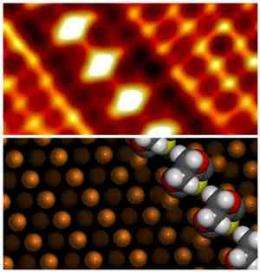Polymer synthesis could aid future electronics

(PhysOrg.com) -- Tomorrow's television and computer screens could be brighter, clearer and more energy-efficient as a result of a process developed by a team of researchers from Canada and the Department of Energy's Oak Ridge National Laboratory.
The synthesis of a conjugated organic polymer--widely used as a conductive material in devices like light-emitting diodes, televisions and solar cells--could mean more efficient, cheaper electronics.
In a paper published in the Proceedings of the National Academy of Sciences, the group of scientists from ORNL and two Canadian universities outlined their success in growing highly structured short chains of polymer poly(3,4-ethylenedioxythiophene), or PEDOT. Analysis and understanding of the polymerization process and results were provided with the help of ORNL supercomputers.
The theoretical expertise provided by ORNL scientists Bobby Sumpter and Vincent Meunier in synthesizing the PEDOT polymer could potentially have an impact on everyday electronic products. PEDOT is valued in electronic applications for the transparency, ductility and stability of its conducting, or doped, state. Because of its role as conductive material in organic light-emitting diodes, PEDOT is found in many electronic devices such as televisions and computer monitors.
The polymer is also used in many solar panel cells as a hole-filling material. "It's one of the most successfully used semiconducting polymers on the planet," Sumpter said.
Improving and controlling the molecular order of a nanostructured PEDOT material is critical to the polymer's performance in electronic applications. The highly ordered polymer arrays such as those constructed by the researchers could lead to increased efficiencies in a multitude of electronic devices.
To create ordered arrays of the PEDOT polymer, the team placed a precursor molecule onto a copper crystalline surface, which helped to guide and initiate the polymerization reaction. Team member Meunier of ORNL compared the process to placing eggs in an egg carton, where the free energy minima, or "indentations," in the copper surface allow the molecules to neatly stack next to each other to form a compact and organized polymer structure.
"The chemistry and resulting stereochemical structure on the surface are very unusual," said Sumpter. "Most attempts to synthesize polymers usually result in imperfect polymer arrays with a very different prominent structure."
Sumpter and Meunier from ORNL's Center for Nanophase Materials Sciences with appointments in the Computer Science and Mathematics Division collaborated in the project by analyzing the results through a "virtual microscope." Based on density functional theory calculations and simulations performed on ORNL supercomputers, the "virtual microscopy" revealed the highly organized structure of the polymer arrays. By examining the polymer formation with the conventional means of scanning tunneling microscopy combined with the virtual microscopy, the team was able to clearly illustrate the construction and bonding of PEDOT arrays.
"This experiment defines what nanoscience is about--a mixture of experimental techniques combined with theoretical knowledge," Meunier said. "It was an excellent opportunity to interface directly with experimentalists and establish new international collaborations."
Although the team focused its research on the PEDOT polymer, the researchers believe the same approach could potentially be used to construct other well-defined polymers.
More information: These findings are published as "Step-by-step growth of epitaxially aligned polythiophene by surface-confined reaction" (Lipton-Duffin et al.) in the Proceedings of the National Academy of Sciences.
Provided by Oak Ridge National Laboratory



















